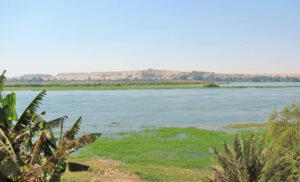This talk was given at the April 2023 meeting of the Essex Egyptology Group, held at 15.00 BST on 2 April 2023 on Zoom.
Click here to download a meeting review >
With thanks to the Gebelein Archaeological Project.
Dr Wojciech Ejsmond presented the most important discoveries made by the archaeological mission working in Gebelein over the last 10 years.
The archival and field surveys program allowed the establishment of distribution, dating, and interpretation of archaeological sites in the area. A geophysical survey provided information on their structure, e.g. extent and plans of several tombs. This allowed, in some cases, research and occupation histories to be reconstructed despite limited documentation from previous fieldwork.
The Northern Necropolis of Gebelein yielded the most extensive finds in the late 19th and early 20th centuries. Available archival documentation and current field surveys allowed us to locate several saff-tombs and mastabas that did not survive to the present day.
The Central Necropolis features two pyramid-shape rocks, that were the focus of attention in the local funerary landscape. This site also has numerous shaft tombs of unknown date.
The neighbouring town of Per-Hathor is more widely known as Pathyris due to several hundred Ptolemaic papyri sourced from its ruins. They provide a vivid image of a provincial centre. Current surveys allowed us to better understand its topography.
The work on the temple in the town brought to light much new information regarding its history and extent. It was part of a broader religious landscape, which is the subject of current studies. One of its key components is the rock-cut temple dedicated to Hathor Lady of Gebelein by Hatshepsut.
This speos was subjected to an epigraphic survey and conservation programme. Also, a previously unknown late Old Kingdom and First Intermediate Period necropolis was discovered. Its rock-cut tomb shed new light on the significance of Gebelein in the 3rd millennium BCE.
Dr Wojciech Ejsmond is the director of the Gebelein Archaeological Project and co-director of the Warsaw Mummy Project. He is an Assistant Professor at the Institute of Mediterranean and Oriental Cultures of the Polish Academy of Sciences.
This talk was preceded by the Essex Egyptology Group’s AGM at 14.00.
